|
|
|
Sort Order |
|
|
|
Items / Page
|
|
|
|
|
|
|
| Srl | Item |
| 1 |
ID:
105902
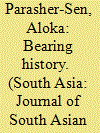

|
|
|
|
|
| Publication |
2011.
|
| Summary/Abstract |
The largely-prescriptive Jaina literary texts contained severe strictures on women that forbade them from undertaking sallekhana- (fasting to death) to attain spiritual liberation. However, fragmentary inscriptions written on stone slabs and pillars found in the Deccan indicate that women did undertake and experience this ritual practice. These records, written at the behest of those who took care of individuals going through sallekhana-, enable us to juxtapose these two sources to argue that there was a dynamic regional religious and social milieu which prevailed over the didactic and normative depictions of an apparently pan-Indian Jaina sensibility. The idea and practice of spiritual liberation during early medieval times in this case study of the Deccan thus illustrates the gender and institutional history of the Jaina faith in its regional and local dimensions.
|
|
|
|
|
|
|
|
|
|
|
|
|
|
|
|
| 2 |
ID:
105904
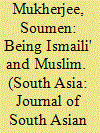

|
|
|
|
|
| Publication |
2011.
|
| Summary/Abstract |
This paper examines the role of politico-religious leaders of smaller sectarian and sub-sectarian Muslim sects in the broader politics of Muslim community consciousness in colonial South Asia. The case of Aga Khan III, the Imam of the Shiite sub-sect of the Khojas, provides our example. This complex process, whereby the Khoja sub-sect increasingly came to identify with the broader Muslim community in colonial South Asia-albeit preserving certain sub-sectarian particularities-is examined with reference to the paradigmatic model of 'path dependence'. The balance that Aga Khan III struck between the socio-religious and political worlds-hinging upon his dual role as a spiritual and a political leader-is deconstructed with the qualified employment of the analytical tool of 'strategic syncretism'. The paper shows how specific socio-religious sub-sectarian traits were effectively retained at the same time as an overarching political consensus forged links between different Muslim sectarian traditions.
|
|
|
|
|
|
|
|
|
|
|
|
|
|
|
|
| 3 |
ID:
105903


|
|
|
|
|
| Publication |
2011.
|
| Summary/Abstract |
t has long been accepted that King Maha-na-ma of Sri La[ndot]ka was involved in a Sinhalese mission to China in 428 AD. However a closer look at the sources on which this claim is based reveals a new perspective on the identity of Maha-na-ma. Data from the Pa-li chronicle, the Cu-avasa, when cross-examined with references found in the Chinese historical records Jinshu, Songshu, Liangshu and Nanshi, and with the travel reports of Wang Xuance and Xuanzang, not only reveal that Maha-na-ma was an international ambassador while he was still a prince, but also show that he was the envoy instrumental in securing the construction of a rest-house for Sinhalese pilgrims near Bodhga-ya.
|
|
|
|
|
|
|
|
|
|
|
|
|
|
|
|
| 4 |
ID:
105907
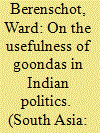

|
|
|
|
|
| Publication |
2011.
|
| Summary/Abstract |
This article discusses the cooperation between small-time criminals (or goondas) and politicians in a locality in Ahmedabad, Gujarat (India). Based on an ethnographic study of local political networks, this article argues that the regular co-operation between politicians and goondas is a product of the inaccessibility of the Indian state to its poorer citizens. The 'criminalisation of politics' is not a sign of moral decay, but a product of the difficulties of (poorer) citizens in dealing with state institutions and the specific nature of the local political competition that these difficulties engender. As local politicians need to develop their capacity to 'get things done' for voters, they need both the 'moneypower' and 'musclepower' of goondas to settle local issues, enforce their authority and manipulate voting.
|
|
|
|
|
|
|
|
|
|
|
|
|
|
|
|
| 5 |
ID:
105906
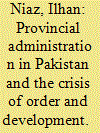

|
|
|
|
|
| Publication |
2011.
|
| Summary/Abstract |
While Pakistani politics regularly employs the rhetoric of provincial autonomy, there are powerful structural and empirical tendencies that have contributed to the centralisation of power. This paper examines the relationship between this concentration of power and the quality of the provincial administration. It argues that unless the provincial administration is rehabilitated and a real measure of fiscal autonomy is granted to the provincial units, Pakistan will continue to suffer a state apparatus and political process that is centralised, arbitrary and ineffective. The effectiveness of the Pakistani state apparatus has become a matter of international concern due to the US-led war on terror and the spill-over of the Taliban/Al-Qaeda insurgency into Pakistan. It is contended that fixing the problems inherent in Pakistan's administration require not only material inputs, but a change in attitude and orientation towards the provincial administration.
|
|
|
|
|
|
|
|
|
|
|
|
|
|
|
|
| 6 |
ID:
105905
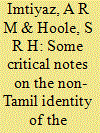

|
|
|
|
|
| Publication |
2011.
|
| Summary/Abstract |
The ethnic civil war between the Tamil and Sinhalese communities that ravaged Sri Lanka in the late twentieth and early twenty-first centuries and which ended in May 2009 has attracted great interest from scholars of ethnic identity. Both the Tamil and Sinhalese ethnic groups employ language-Tamil and Sinhalese-as their primary ethnic marker to support their distinct ethnic formations. As for the Muslims, while the vast majority living in the north and east share many things with the Tamils there including the Tamil language, Muslims in the south have divergent interests based more on trade and commerce. Under a predominantly southern leadership, the Muslims who speak the Tamil language with some borrowed Arabic words seek a social formation based on religion to win a distinct ethnic recognition-distinct from the Tamil ethnic group. The result has been a deep rift between the Muslims and the Tamils, making a permanent solution to Sri Lanka's problems elusive. These issues have been relatively under-researched. This study looks at Sri Lankan Muslim identity and the Muslims' relations with Tamils. In particular it interrogates some aspects of the identity discourse developed over the years by the south-centred Muslim elites who align with the Sinhalese political class. We argue that the Tamils' northern leadership has been insensitive to Muslims-that they have played into the hands of the Colombo government by persecuting Muslims in their midst on the pretext of responding to government-instigated violence among local Muslim youths.
|
|
|
|
|
|
|
|
|
|
|
|
|
|
|
|
| 7 |
ID:
105908


|
|
|
|
|
| Publication |
2011.
|
| Summary/Abstract |
This paper explores the emergence of violent child identity politics in a communally sensitive urban slum in Hyderabad, a city in southern India. My ethnographic landscape is Sultanpur, a Muslim-dominated ghetto in the northern quarters of Hyderabad, which has been marked by decades of hostilities between local Hindus and Muslims. These tensions had everyday and extreme manifestations (ranging from quotidian expressions of symbolic violence to rioting, looting and bomb blasts) which increased the vulnerabilities of Muslim male children in the slums; the latter being humiliated by ordinary passers-by in times of peace, and at other times being attacked by rioting mobs. To counter their victimhood and organise their own retribution, sections of local boys in Sultanpur, aged between 9 and 14 years, co-ordinated themselves into child squads (bacchon ke fauj). These child vigilantes patrolled the slum borders and common public places, constantly establishing a disciplinary control over fragile aspects of ghetto life. For example, the male child squads not only aggressively prevented members of other communities from entering the slum, they also monitored the movement of Sultanpur-wallahs, often physically assaulting local women who were caught having affairs with Hindu men. In my paper I show how the power, presence and practices of these child squads upturned traditional structures of male and female authority, contested conventional notions of male childhood in a volatile urban space, and sustained nascent masculinities within the moral and social economy of impoverished Muslim male children.
|
|
|
|
|
|
|
|
|
|
|
|
|
|
|
|
|
|
|
|
|